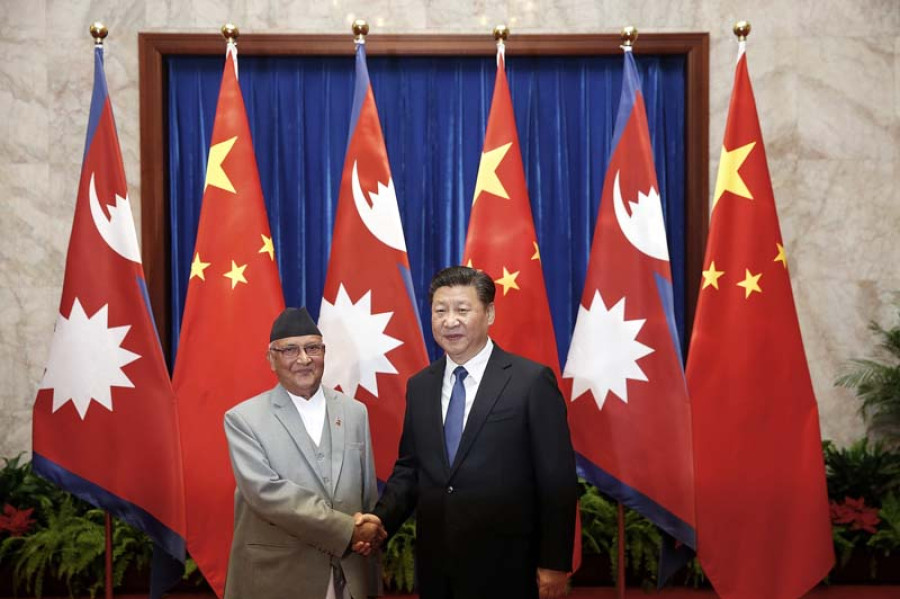National
Three years of inaction have led to doubts if the transit agreement with China will ever materialise
Despite Nepal notifying the Chinese about the readiness of its transit preparations in July, China has yet to respond.
Anil Giri
When Prime Minister KP Sharma Oli signed the Trade and Transit Agreement with China in 2016, it was heralded as a major step in Nepal’s attempts to break free of its dependence on India. The agreement, when it came into effect, would provide Nepal with access to four seaports and three land ports in China for third-country trade.
More than three years later, there has been no movement regarding the agreement, giving rise to concerns that the agreement might never be implemented.
In order to implement the agreement, Nepal and China had signed the protocol on Nepal-China transit, during President Bidya Devi Bhandari’s visit to the northern neighbour in April. The protocol requires both sides to ready their infrastructure and officially notify each other. Nepal duly notified China in July that all preparations were complete but China has yet to respond.
“We have yet to receive confirmation from China regarding the protocol,” Baikuntha Aryal, secretary at the Ministry of Trade and Commerce, told the Post over the phone from New Delhi, where he is taking part in a trade and transit meeting. “Once China notifies us, we are prepared to receive some cargo from Chinese seaports up to the Nepal border.”
According to two Nepali officials based in Beijing and Kathmandu, the Chinese delay can be attributed to the involvement of multiple Chinese agencies who need to coordinate to provide clearance for Nepal to use the Chinese sea and land ports. The Chinese are also concerned about the status of infrastructure on the Nepal side, said the officials.
But according to Nepali diplomats and experts who negotiated the transit agreement with China, there are numerous problems with the agreement itself, especially the lack of clarity in its text.
“If Nepal and China really want to implement the protocol, they will first have to amend the protocol,” said former commerce secretary Purushottam Ojha. “The protocol fails to describe the modality of export and import of goods from third countries via Chinese sea and land ports. A lot of issues have been left up to the Chinese customs to handle.”
A lack of clarity over these preconditions means Nepal has been not able to bring in a sample consignment from Chinese seaports. And without a sample consignment, importers do not know how much time it will take to bring goods from the nearest Chinese border up to Nepal border, the cost of the consignment and what procedure and modality Nepali importers need to follow.
The transit agreement has also been overshadowed by other bilateral issues, including projects under the Belt and Road Initiative (BRI), especially the cross-border railway.
The protocol was listed as part of the Nepali agenda during Chinese President Xi Jinping’s visit to Nepal in the second week of October and Chinese Foreign Minister Wang Yi’s visit in September, said officials. The Ministry of Trade, Commerce and Industry has also been taking up the issue with the Chinese side ever since Nepal notified China regarding the protocol.
Former Nepali Ambassador to China Mahesh Maskey, who did extensive work on the Transit Agreement with China in 2016, said that several important issues like transit protocol, petroleum imports from China, and establishing a cross-border economic zone along the border have all been overshadowed by projects under the BRI.
“The agreement could have political significance but what will we gain? What measures have we taken to reduce the widening trade gap with China?” said Maskey. “We convinced China to sign the agreement, we pushed them. But we haven’t built a blueprint for the future course of our ties.”
The protocol, once it comes into effect, will allow Nepal to access four Chinese seaports—Tianjin, Shenzhen, Lianyungang and Zhanjiang—and three land ports—in Lanzhou, Lhasa and Shigatse—for third-country trade.




 15.12°C Kathmandu
15.12°C Kathmandu















